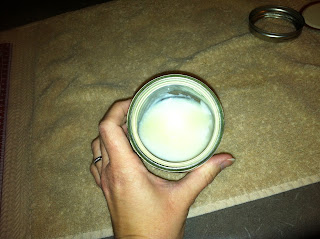LAB
Chicken Leg
Dissection
Image Taken from: http://www.123rf.com/photo_15498129_yellow-chicken-in-green-grass.html. on April 14, 2013
Procedure:
1.
Put on gloves and collect your tools.
2.
Thoroughly rinse and dry one chicken leg. Place
it in the dissecting tray.
3.
Examine the outside skin tissue. This is the
epidermis and the dimples are where feathers emerged. Using scissors and forceps.
4.
Cut the skin and peel it away from the muscle.
5.
Notice the clear connective tissue that holds
the skin to the muscles. As you peel off the skin, you may need to cut away
some of this connective tissue. Work slowly and carefully with scissors and
forceps until all skin is removed.
6.
Describe how the connective tissue looks and
feels. What type of connective tissue is this?
The
connective tissue under the skin, which was holding the skin to the muscle, is
areolar connective tissue. It was not very dense, but it did require the use of
scissors during the removal process in some areas. It felt slimy and stringy.
7.
Observe, with your naked eye bundles of muscle
tissue surrounding the bones. Separate the bundles of muscles by separating them
out with your fingers. Begin by inserting your thumb into the muscle of the
lower leg. You will need to push forcefully through the shiny lining (called
fascia) over the muscle, but it will give way at the natural separations
between the muscle bundles. Continue separating the muscle into bundles by
forcing your thumb and fingers through the muscle until you are able to
distinguish several separate bundles.
a.
Describe the arrangement of the muscle
bundles.
The muscle bundles seemed to be
small groups of long bundles connected together. The bundles did not have
breaks in them… meaning that they went from one connection to the other as a
continuous structure.
8.
The strong, shiny, white cords, called tendons,
hold the muscle to the bones. Some of these tendons will pull away from the
bone as you separate the muscle bundles. Use a probe, if needed, to find the
tendons of the chicken leg. Using the dissection scissors, cut across the
tendons at Line A (Figure 1). Observe the numerous tendons and pull the freed
muscles down and away from the bone, as if you were peeling a banana. Careful
you don't cut any ligaments that attach bone to bone. Look closely at the
ligaments.
Examine the two bones in the lower leg. The
large bone (Bone A) is the tibia. The small, toothpick-like bone (Bone B) is
the fibula.
a.
What sort of connective tissue are tendons
composed of?
Tendons are composed of dense
fibrous connective tissue.
9.
Remove a single muscle by cutting the tendons
and peeling the muscle away from the bone.
a.
What sort of muscle tissue is represented?
How do you know?
The muscle tissue that is
represented is skeletal muscle tissue. I know this because it is connected to
the skeleton. The muscles also seem to be composed of long, continuous fibers,
which is characteristic of skeletal muscle. It may also be suggested that this
muscle is composed of slow-twitch fibers based on the very red appearance.
b.
Nerves are generally thin, threadlike white
strands found between the muscle and the
nearest bone. Look for the nerve in your specimen. Did you find them?
Not sure if I found them or not. I
am sure it was there but I am unclear if I identified it correctly.
c.
What is the physical difference in the
tendon of the insertion when compared to the origin?
At the intersection the tendon was
more narrow but also more dense. At the origin, it was wide and less dense.
10. Remove
all remaining muscle to expose the bones of the chicken leg.
a.
What is the soft material inside a bone?
The soft material inside a bone is
called marrow.
b.
Name three specific types of cells present
here. Do not break the bone; it is sharp!
Bones contain osteocytes,
osteoblasts, and osteoclasts.
c.
Name three functions of bone.
Three functions of bone are
support, movement, and protection. Two other functions are mineral storage and
blood cell formation.
11. Cut
onto the hinge joint by cutting into the top of the covering of the joint from
the femur side. It will become apparent that you must remove the knee cap area
to expose the menisci and ligaments within. Pull up on the knee cap area and
cut through it with the scissors. You will have cut through the bursa, a sac
that acts as a shock absorber for the knee joint. These are found in every
joint.
12. Pull
the covering back and look into the inside of the joint. You will see more
white bands of ligaments holding the bones together. Observe the shiny, white
layer covering the ends of the bones is cartilage. It helps the bones slide
smoothly when the leg bends.
13. Bend
the specimen at Joint B (Figure 1) and rotate the femur in all directions.
Remove the muscle that covers Joint B by cutting parallel to the femur, upward
toward the backbone. Remove pink muscle tissue until you see a shiny white
sheet of ligament that covers the joint. Present is an exterior ligament that
holds the femur in the hip socket
a.
What type of connective tissue composes the
ligaments?
Ligaments are composed of dense fibrous
connective tissue.
-->
*** This was a great learning experience, and, as a side note, I think I will be avoiding chicken for a while ***






















